#Modern Poem in Hindi
Note
https://vm.tiktok.com/ZGejUxD5k/
The comment of making a song in Ancient greek just to piss of Greeks what's the purpose of it? As a Greek i wouldn't mind someone foreigner trying to learn Greek, so just making this comment a video provokes a negative behaviour.
My problem with this is that I am so annoyed at the person who made the request like this ("make the Greek mad") but it gets worse because there are Greeks getting mad at the comments in a wrong way so that person is proven right :////// That person makes a reference to the long standing animosity between modern Greek speakers and western classicists obsessed with the Erasmian pronunciation. Or the reconstructed one. The TikToker has had beef with Modern Greek speakers in an older video. That's what was referenced there.
Anyway, the tiktoker himself is not wrong in his recitement when it comes to the technical aspects of it. The problem with it is that - who knows how - even though he employs the prosody in the recitation, he still sounds incredibly monotonous. And incredibly English lol. If I had to listen to all that by a rhapsodos as an Ancient Greek I'd rather kill myself. Imagine 15,693 lines of verse like that. Listen to it and tell me I am wrong.
And not to be that person, but the TikToker kinda looks like he's torn between being the most English person ever and the descendant of Brad Pitt's Achilles.
I am so mad at Greeks because the radical western classicists (new term I just invented!) lack so much self-awareness that it would be easy for Greeks to argue, and yet Greeks are divided between "GREEK PRONUNCIATION SAME ALL THE WAY BACK TO 1000000000 BC" and "a blondie said it therefore it is the unquestionable truth and I dare not develop an insight on it by myself". There's no in between. I hate us.
And I say they lack self-awareness because even though they obsess so much over the textbook, (which is western theories mixed with western interpretations of scarce ancient Greek sources, without questioning even for a second the accuracy of said interpretations and even the ability of the ancient texts to convey in script the sound and the oral delivery of the language accurately and easily enough for foreign people to understand it perfectly many centuries later and with no exposure whatsoever to said language), they fail so much at removing the inherent elements of their own language.
Like, when Ancient Greek was said to be a very beautiful and unique sounding language, and you end up sounding like the blandest English gibberish poem ever, something must not be quite right. This is not evident just in Greek. He speaks a lot of languages (and kudos to him) but he said Mahabharata and it was like "Muh- hub- arr - atttah... and a cup of tea, please". Come on. I was petty enough to pronounce Mahabharata loudly and then went to GoogleTranslate and listened to the pronunciation in Hindi (no pronunciation option available for Sanskrit). I am closer to it than he is. (3,2,1 until some wild Brit classicist claims the English version is closer to Sanskrit than Hindi is XD). But okay it was petty and not all that scientific on my part, I admit.
Whoever wants a GOOD recitation of Ancient Greek, try Ioannis Stratakis - Podium Arts on YouTube. He sticks to the "textbook" and so far he is the best I have heard.
P.S. I saw somewhere in the comments under his posts the explanation / excuse that some words have to be pitched / stressed incorrectly in prosody because otherwise they won't fit in the hexameter.... while this indeed has to happen sometimes, if it happens too often you are doing something wrong, Greek is one of the best languages to modify and switch the placements of words in order to fit in the meter or rhyme just right and if memory serves me, “having to be incorrect” not as a frequent occurence as stated.
PS2: the more I listen to it the more need for such excuses I notice….
52 notes
·
View notes
Text
DAY 5401 ( i )
Jalsa, Mumbai Nov 27/28, 2022 Sun/Mon 12:23 AM
💛🪔 ,
November 28 .. birthday of Ef Ashok Manwani from Delhi .. love and greetings ..
Poonam .. our lovely smiley .. your wedding anniversary was on the 27th .. on the birthday of Babuji .. we know it was hard for you .. but we want you to know that your Ef are with you in thoughts and prayers .. all of us .. sending your way our affection and 🤗🤗🤗 .. take care .. keep well .. keep smiling .. you're not alone ..
.. and .. to Ef Ambar Mukherjee from Dubai .. their 13th Marriage Anniversary .. also on the 27th .. our prayers of the ever love and togetherness .. 💍💕🎉
✨
And .. down memory lane ..
.. on this day .. 28 November 2016 .. Astra Force .. the animated superhero television series .. was telecasted by Disney India Channel .. it was a cute one .. and I enjoyed watching it .. 🥰
.. the creator that created me .. that gave me the essence of all that he creatively created .. that created in me the desire the will to be the one that I be today - a HUMAN ..
Nothing more ..

the Sundays begin again .. with love and grace ..

... a bench made of stone in Wroclaw , Poland in the shape of a book - Madhushala .. intricate and most uniquely done .. weighs a ton .. brought from Poland, through the kind offices of the Counsel general India in Wroclaw , Shri Kartikeya Johri , who worked assiduously in putting up the elf statue of Babuji in Wroclaw, a stamp in his honour and now has worked on opening a Research Centre for the study of modern Hindi literature in the name of Babuji - Harivansh Rai Bachchan, Research Institute ..
As we all know, Wroclaw in Poland has been declared the Heritage City by UNESCO and Universities there now have an entire section for the study of Hindi .. a moment of great pride for India ..
And as the Ambassador for the City of Wroclaw an immense moment of gratitude that Poland gives to India and indeed the study of Hindi Literature ..



.. a book bench .. Madhushala
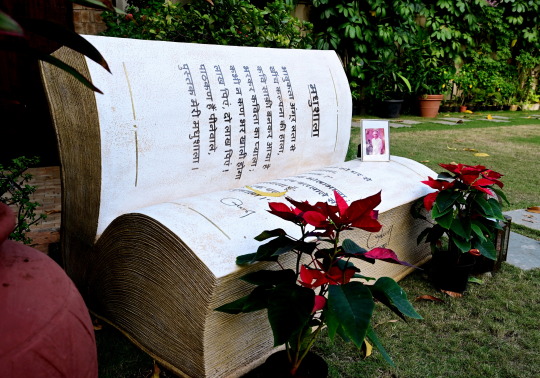








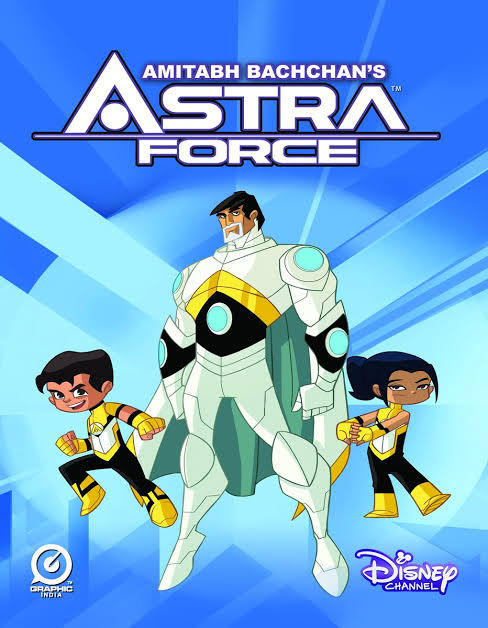

.. all this Astra was initiated but have no idea what became of it .. I did voices for this as well ..


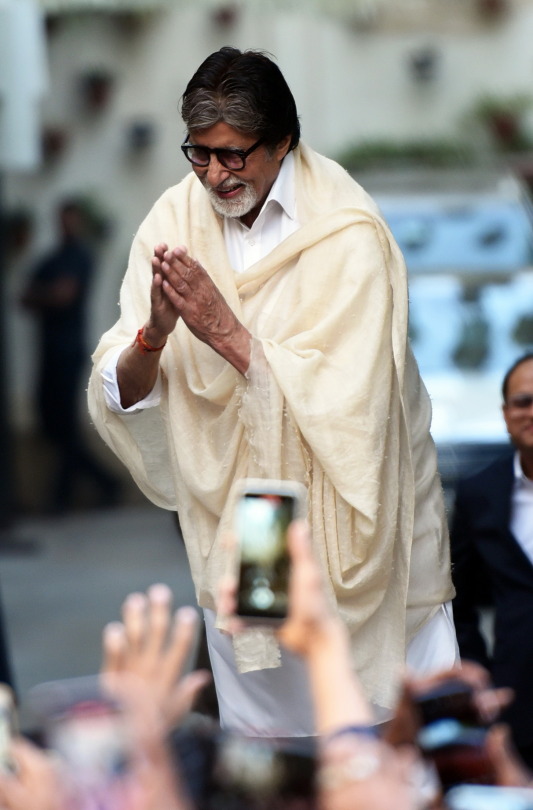




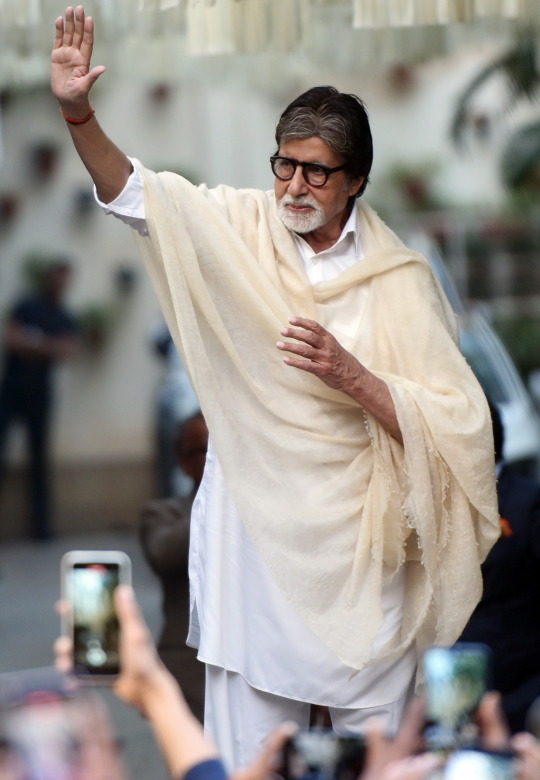

... my gratitude as ever for the well wishers on Sunday at the gates of Jalsa .. standing behind me is the Counsel General Kartikeya Johri, who organised the bench to be brought . ..

.. and in the remember of Babuji, how auspicious to have that bench installed today in our lawns at Jalsa ..
and in his memory and thoughts his famous lines from an important poem of his :
mitti ka tan ; masti ka man ; kshan bhar jeevan , mera parichay
my body made of the mud of the Earth ; my mind filled with the joy and happiness of life ; a life of momentary time , that be my introduction
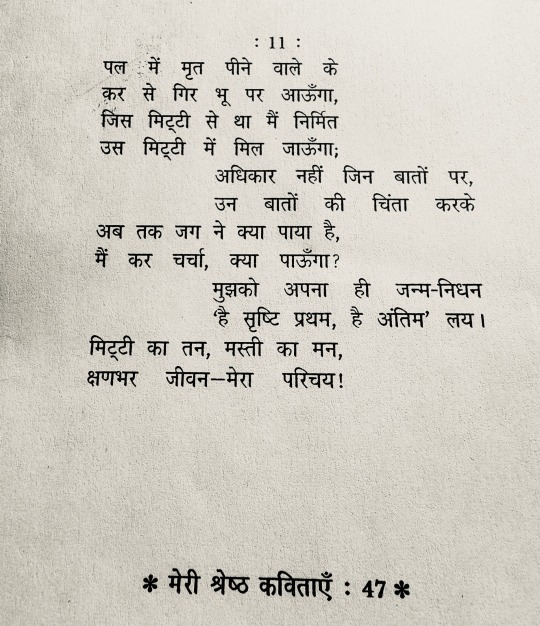
in his arms and mind and body do I sublimate myself .. in prayer in devotion in selfless immersion ..
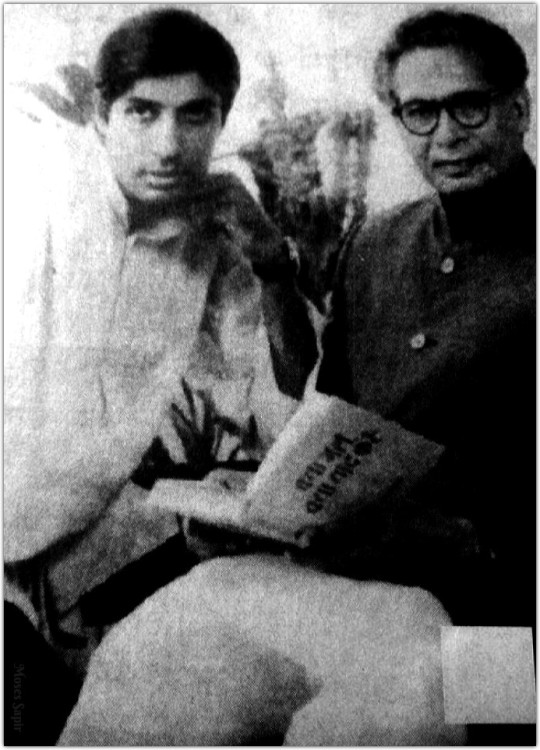

Amitabh Bachchan
152 notes
·
View notes
Note
I'd love to know more about "palutena trap (kid icarus meets the parent trap)"
Ok so I just answered an ask about this with a bit about the inspiration and approach I'm taking to this fic so this one I'm going to list some of my favorite plot points in no particular order:
This is a "modern au" so everyone has normal jobs, such as:
Investigative journalist who lives on a houseboat
Mob boss
Lead singer for a punk band which is actually a front for an eco-terrorist group
Karate sensei
Drag racer
Ex-MI6 butler
California surfer bro
Dark Pit, given the option refers to himself exclusively as "The Dark Falcon of Vengeance" or similar because I couldn't stretch my suspension of disbelief enough to call him Dark or to give him a different name entirely (much as I love @stonemaskedtaliesin's Pip, it just doesn't fit in the context I'm going with)
Dark Pit's actual name in this is Pit Pairisetti, and Pit's name is Pit Pasupati. Dark Pit's name is a more alliterative romanization of Bairisetty, a Telugu surname which means something like "falcon," which I thought was appropriate. Pasupati is a Hindi surname which was mostly picked because I liked the way it sounded and wanted both of their surnames to start with the same letter, giving the camp counselors an excuse to call them Dark Pit and Light Pit instead of just using their last initials.
Pit is going to mostly accidentally steal a team of horses from Hades as part of an escape when he's doing something with the Forces of Nature as the analog to the canonical Lightning Chariot. It will be glorious.
There is a Sonic expy who will never appear on-screen who is Phosphora's greatest nemesis (and possibly ending scene implied love interest, depends on if I think of anything funnier)
The background ship is past Palutena/Medusa and I haven't yet decided how much reconciliation they will do. Less than in The Parent Trap, for sure, but maybe more than I originally planned.
Medusa and Dark Pit know all the sorry details about their breakup, but Palutena never explained it to Pit
Despite their incredible athletic skills, both Pits sink like a rock in water.
As you might have gathered from their names, I am making Palutena and Medusa Indian, specifically from Northern India and Southern India, respectively. This is mostly because I can and encouraged by the fact that there's a species of parakeets from India that have naturalized to Greece. I'm pretty sure they're the ones from the tumblr poem about unmannerly peas, which is one of my all time favorites, so even better.
They met in Hyderabad and decided to marry each other instead of waiting around for whatever arranged marriage their families had planned for them. This is also why neither of them can go home because they would literally rather die than hear their aunt sigh and go "this is why blah blah blah."
They won the houseboat from Poseidon in a poker game. Palutena played the cards, Medusa helped her cheat.
The divorce was really ugly. Like, dragged through all the tabloids levels of ugly. Pit doesn't know about it because all of his electronics have parental controls about that specifically. It ruined Medusa's PI firm, which is why she now works for the mob boss.
This is why Pit just knows about the bad things Medusa has done (there was a REASON the divorce was ugly and it was not all Palutena's fault) but Dark Pit knows about things that Palutena said about him, specifically.
The Pits spend some time at camp bonding in the counselors-only Jacuzzi, and possibly over a camp play. Can't decide how much Addams Family Values I want to throw in.
Hades has eaten human hearts before, but prefers Amazon River Dolphin. He says the stench of evil ruins the taste.
Despite all the plot I have planned out (this is going to be so much longer than TFP) I feel like I have so much less of it planned out than TFP (which, to be fair, is a murder mystery). It's always a big shift to jump from one to the other, and it's going to be even more of a shift once I finish TFP and start editing and posting in earnest, but I'm looking forward to trying a different style of editing when I get there!
#I love all of the absolutely wild plot in this one it's my favorite thing#palutena trap#my writing#eriquin#kid icarus
11 notes
·
View notes
Text
THE GARDEN OF POETRY,EPISODE 12
Firstly Thankyou! you for your immense love and support towards the last blog it's always so fun! to read your comments and suggestions about the blog. So this adventure of mine took me to the most Poetic Place in Delhi which remains hidden from most admirers. So let's explore this place together! I started my journey toward the posh area of Vasant Kunj with these lines of poetry by Ahmad Faraz it goes Search for pearls of loyalty amongst those who are uprooted Maybe you will find these treasures in the ruins of the taverns". with these lines, I started my journey toward the infamous Poetry Garden. As was moving along the street of the prosperous Vasant Vihar I saw this astonishing Graffiti.

I stood there and gazed at the portrait for a minute thinking about the mysterious vibe of the painting. I somehow stopped myself from staring at the portrait and moved forward. With a left turn from Malai Mandir, I arrived at Priya Garden. As I entered the garden a felt a strange smell. A smell of love, beauty, and the past we all have forgotten. As I glanced around the place I saw these beautiful writings by the famous poet on a rock.
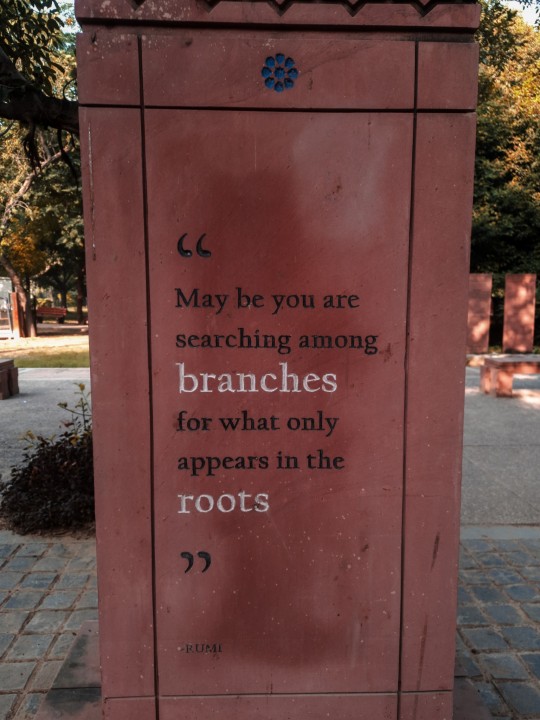
These verses were on stone surrounding a luscious tree whose trunk is so entangled in vines that it looks like a sage's knotted hair. I was lost in a world of happiness after reading these lines. They appeared as if these were some clues to an unknown enigma. As I blinked I saw a signboard providing directions to the other parts of the Park. I followed the path toward the historical garden.

The vibes of the place were so pleasant and awesome that it was hard for me to believe that I was really in Delhi. The green silage and the small wooden yoga areas gave the place a new and different outlook. As I moved forward I cannot comprehend what I was looking at....
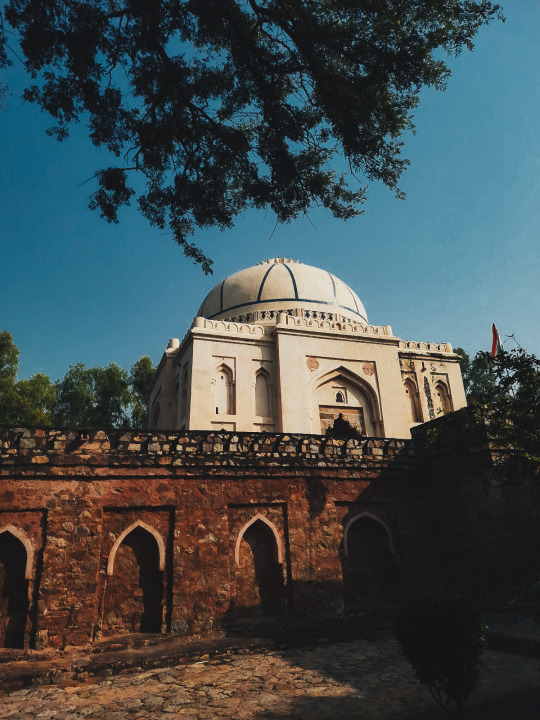
The place looked so royal and out of the world. The gumbad was shining white with designs made of blue marble and the rest of the structure was made with identical red stone which was used in Lodi structures back in the time. The entrance had a big lock at the main door when I insisted the security guard unlock the place he only allowed me to enter on the condition that I would not click any pictures. The monument was tremendous from the inside it also had a small mosque attached to it.
(View of the Park from the monument)
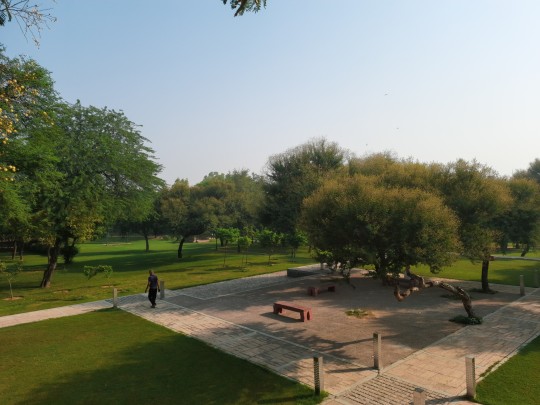
As I was leaving the place I saw a place out of the normal. It looked a bit different from the surrounding area. When I went a bit forward I sensed a strange beauty coming from the place.
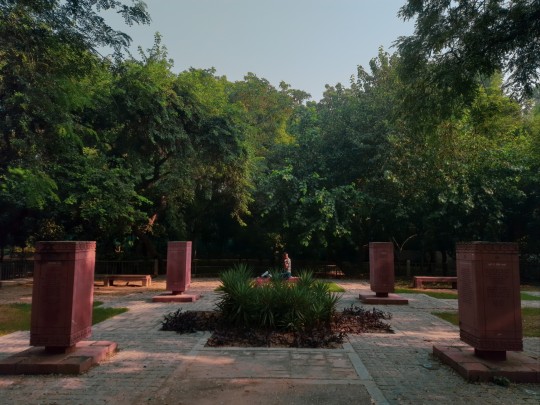
As I was trying to know about the area I saw a sign which said POETRY GARDEN. I got excited after reading that I was standing in the main Poetry Garden! I continued reading the board it further said that the four stones in the garden contain verses from two of the most renowned Tughlaq era Persian poets namely Amir Khusrau and Hafez, to create harmony and a symphony of songs. Lyrics that are dedicated to the glory of bountiful nature, and sing the praise of spectacular tres. As I read these lines I jumped from my cycle to read the poems.
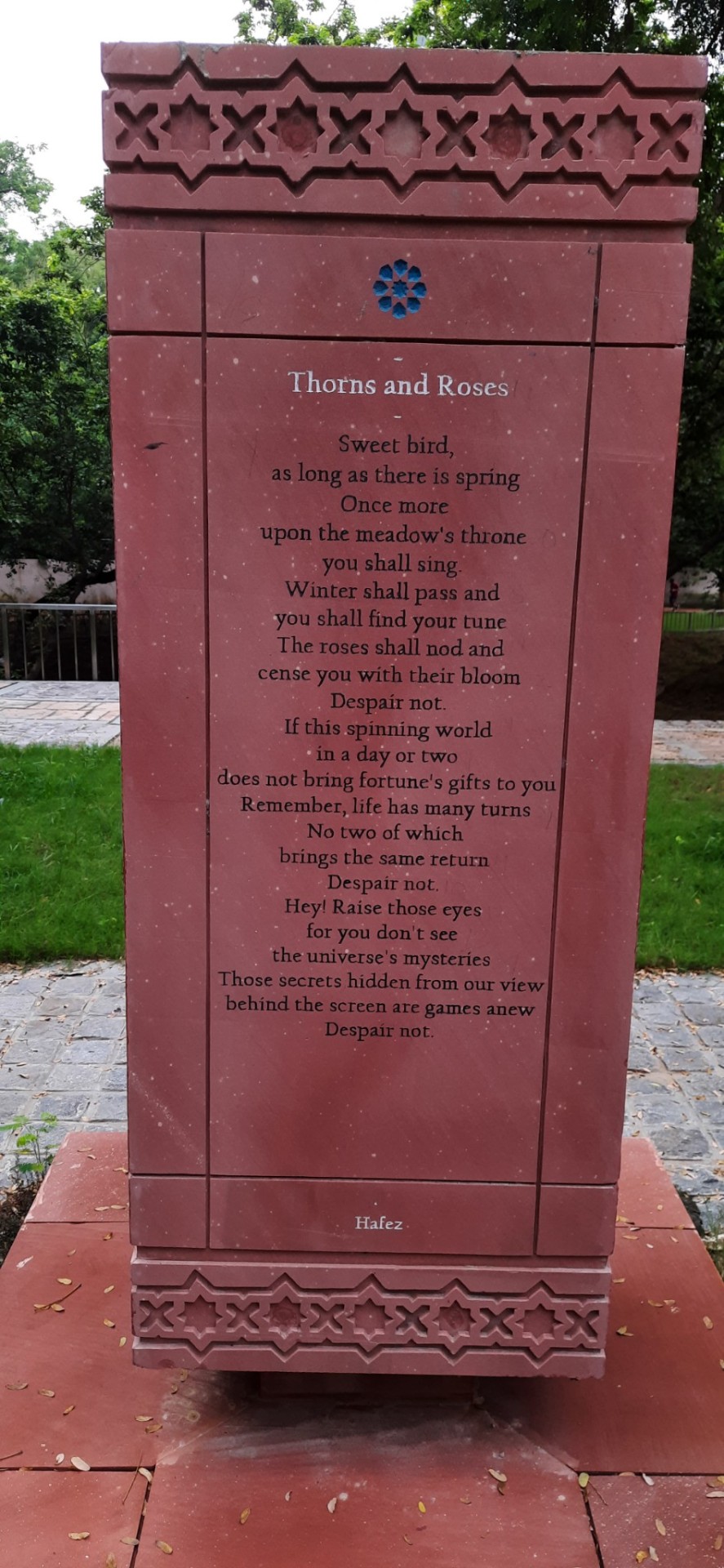
For the admirers, the poems were written in 3 languages Hindi, English, and Urdu. And trust me each of the poems where so beautiful and unique that it made me wonder how the garden might have looked back then when these poems dedicated to the garden might have been written. The Poetry Garden was situated at the axis, which Inconspicuously connects the Baradari and the mosque. Just like Naubagh which was originally laid by the Mughals.

As I was admiring the place saw this open theatre in the middle of the grassland which resembled the amphitheater found in the gardens of the modern Western world.
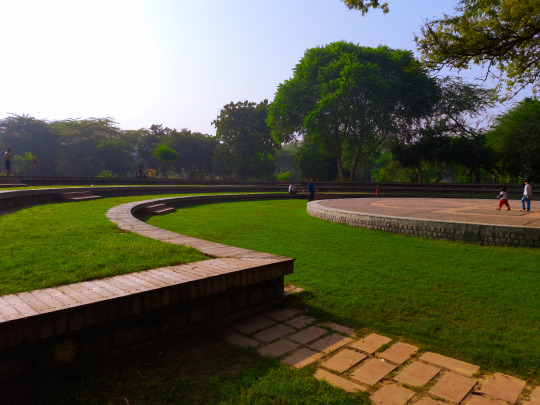
The amphitheater perfect was a perfect place to sit and hear yourself contemplating in unison with time. It was named "Gulzar" to keep the cultural ethos of Bagh-e-Bahaar intact, which is filled with references to springtime, trees, flowers, and mellow fruitfulness. In Persian, flowers are called 'Gul', and hence a flower garden is termed as 'Gulshan' or 'Gulistan' 'Gulzar' in that sense, would stand for a place, which is rich with joyful excess.
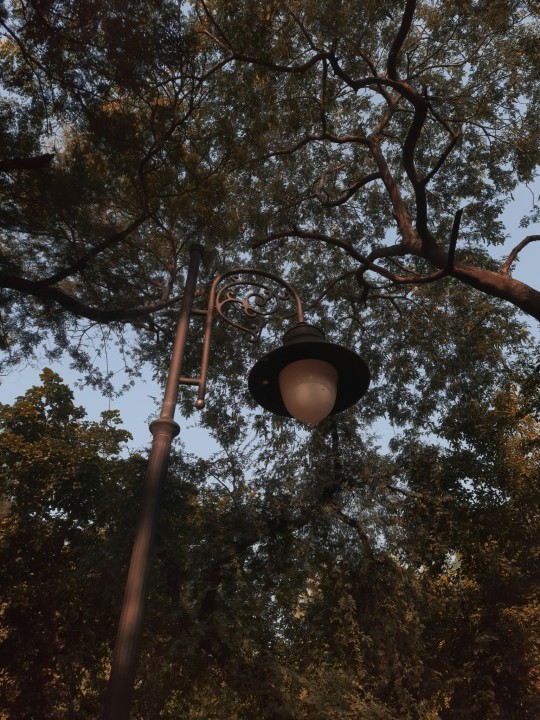
I also noticed that many trees in the park were of the Amaltas. They lay a carpet of yellow flowers on the ground, when in full bloom, and create the magnificent ethos of springtime. I somehow managed to come back from this magical place and returned home here is a video about the place.
According to my research Bagh-e-Bahaar Situated in Vasant Vihar, in an area spreading over 18 hectares, this garden was laid out by Firuz Shah Tughlaq (1309-1388), in a 12-hectare area of the same lie remains of the garden originally laid. Most constructive of all Sultans. Firuz Shah is known for establishing cities and citadels like Firozabad, Kotla, and Hisar Firoza, as well as digging grand canals like Ulugh Khani and Razali. His biographer Afif notes in Tarikh-i-Firuzshahi that, Sultan had laid out or resurrected some 1500 gardens in Delhi and its close vicinity. Firuz had a liking for fruit gardens or orchards, and his gardens would also cultivate grapes among other fruits. This is the last surviving garden of those 1500 baghs that the Sultan had laid. Persian literature celebrates gardens earthly as representation of Paradise. The very first Mughal Garden of India, laid by Babur in Agra, is called Hasht-Bahisht and the word Bahisht itself stands for the Paradise.This was much before the Taj Mahal or the Humayun's Tomb which now stand splendid as examples of Tomb Gardens. The design schemecreates a Charbagh for the Tomb and the Baradari. A small water feature, reminiscent of water channels, is neatly tucked in the geometry. The axes of the Charbagh are complemented entirely by the entrances towards the Poorvi Marg and Basant Lok Complex. So with that, I end this blog of my marvelous adventure to the infamous Poetry Garden.
Until next time with love
Aryan Sachdeva
#photography#explore more#poesía#poetry#aestheitcs#delhi#artists on tumblr#likeforfollow#long reads#blog#writerscommunity#the ancient one#love poetry#original poem#photografy#museums#conservation#100#original work#my work#antiques#archaeology#tumblr memes#instagram#india#garden#love#lost#writerslife#my blogs
57 notes
·
View notes
Text
Caught Up To The Heavens - The Esoteric Santism of the Tulsi Sahib Satsang - Spiritual Awakening Radio Podcasts

Mystic Poem of Sant Tulsi Sahib of Hathras: Within This Body:
"Within this body breathes the secret essence.
Within this body beats the heart of the Vedas.
Within this body shines the entire Universe, so the saints reveal.
Hermits, ascetics, celibates all are lost, seeking Him in endless guises.
Seers and sages perfectly parrot the scriptures and holy books, blinded by knowledge.
Their pilgrimage, and fasting, and striving but delude.
Despite their perfect practice, they discover no Destination.
Only the Saints who know the body's heart have attained the Ultimate, O Tulsi.
Realize this, and you've found your freedom
(while teachers trapped in tradition know only the mirage in the mirror)."
Spiritual Awakening Radio Podcast - Caught Up to the Heavens, The Esoteric Santism of the Tulsi Sahib Satsang @ YouTube:
https://youtu.be/6sMtylkVov8
Spiritual Awakening Radio Podcast - Caught Up to the Heavens, The Esoteric Santism of the Tulsi Sahib Satsang - Listen/Download @ the Podcast Website:
https://SpiritualAwakeningRadio.libsyn.com/caught-up-to-the-heavens-tulsi-sahib-and-the-gnostic-saints-of-india
Listen @ Apple Podcasts:
https://podcasts.apple.com/us/podcast/caught-up-to-the-heavens-tulsi-sahib-and-the/id1477577384?i=1000612594155
Follow @ Apple Podcasts:
https://podcasts.apple.com/us/podcast/spiritual-awakening-radio/id1477577384
@ Spotify:
https://open.spotify.com/show/5kqOaSDrj630h5ou65JSjE
@ Google Podcasts:
https://podcasts.google.com/feed/aHR0cHM6Ly9mZWVkcy5saWJzeW4uY29tLzIwNzIzNi9yc3M
& @ Wherever You Subscribe and Follow Podcasts (YouTube, Apple, Spotify, Google Podcasts, Amazon, Audible, Stitcher, PodBean, Overcast, Jio Saavan, iHeart Radio, Podcast Addict, Gaana, CastBox, etc...):
https://linktr.ee/SpiritualAwakeningRadio
Today during this Satsang Without Walls some rare passages from the world of esoteric Santism translated from Hindi, the writings of Sant Tulsi Sahib of Hathras, India and a few of his spiritual successors on this Path of the Masters, Inner Light and Sound Meditation, the Way of the Soul Merging into the Heart of the Beloved, the Ocean of Love in the Nameless Plane (the Anurag Sagar of Sat Purush Anami Radhasoami).
"Only by breaking the bonds of mind, illusion and time is one free from the cycle of transmigration." (Sant Prakash Das)
"Complete Mahatmas, Genuine Saints came to the world in their respective times and kept on emancipating the living beings who were connected with them. On completion of their time, they left the body as per the will of the Lord and went to the Lord and left their work [their spiritual mission] to the other saints when departing." (Sant Prakash Das)
"The true master practices the spiritual Sound and Light that comes from beyond. By these methods of meditation, the soul becomes introverted through regular practice and hears the melodious Sound within, and the soul reaches where the Sound is emanating from. This is the goal of the practice of Surat-Shabd-Yoga." (Sant Prakash Das)
Like Galileo discovering new worlds through the lens of his telescope, mystics of the East and West (Jewish mystics, Christian Gnostics, Sufis, and in modern times, the Sants and Radhaswamis of India: Path of Sant Mat) have been trying to tell humanity for eons of something quite similar... about another kind of space... Inner Space. The reason why the contemplative state of being is still hidden from most of us is that, unlike Galileo’s telescope, in order to look through this particular lens, we mustn’t focus on the outward sensory impressions, but go in the opposite direction: into Inner Space. Look through the lens of the third eye to access the world of within. But one has to be willing to take the cap off the lens and have a look, to actually do the meditation. If we do follow the methods of meditation practice revealed by the Masters, with the third eye we will behold the Inner Light, Inner Visions, hear the Sound of Silence, the Holy Stream of Sound -- Music of the Spheres, traverse the heavens for ourselves, and return home to the Beloved Lord of Love, the Lord of the Soul.
In Divine Love (Bhakti), Light, and Sound, At the Feet of the Masters, Radhaswami,
James Bean
Spiritual Awakening Radio Podcasts
Sant Mat Satsang Podcasts
A Satsang Without Walls
Sant Mat Radhasoami
https://www.SpiritualAwakeningRadio.com
#wordpress#tumblr blog#podcasts#youtube#apple podcasts#spotify#google podcasts#spiritual awakening radio#satsang#sant mat satsang podcasts#james bean#spirituality#meditation#india#gnosticism#mysticisim#mystics#sant tulsi sahib#kabir#anurag sagar#sant mat#radhasoami#inner light and sound#soul travel
15 notes
·
View notes
Text
Kumar Vishwas: The Poet-Politician Who Redefined Indian Literature and Public Life
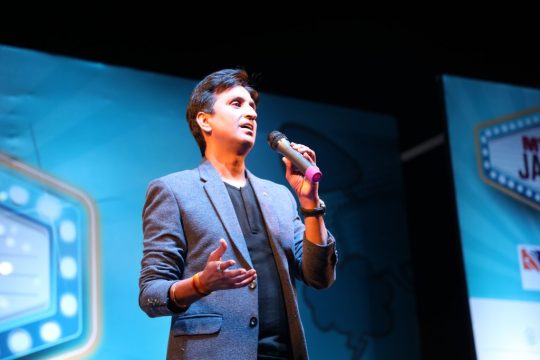
Kumar Vishwas is a prominent figure in contemporary Indian literature and politics, renowned for his captivating poetry and engaging public persona. A celebrated Hindi poet, social activist, and former politician, Vishwas has left an indelible mark on India's cultural and political landscape. His journey from a small-town poet to a national political figure is both inspiring and multifaceted.
Early Life and Education
Born on February 10, 1970, in Pilkhuwa, a small town in Uttar Pradesh, Kumar Vishwas was raised in a middle-class family. His father, Dr. Chandrapal Sharma, was a teacher, and his mother, Rama Sharma, was a homemaker. From a young age, Vishwas was inclined towards poetry and literature, much to the concern of his family, who initially encouraged him to pursue a more traditional career.
He completed his primary education in his hometown and went on to pursue a degree in engineering, but his love for literature pulled him in a different direction. He decided to follow his passion and pursued a Master's and Ph.D. in Hindi Literature. This shift laid the foundation for his future as a poet and public intellectual.
Rise to Fame in Poetry
Kumar Vishwas first gained national recognition for his poetry, which resonated with the youth of India. His romantic verses, often laced with humor and deep emotions, struck a chord with audiences across the country. He became a regular performer at Kavi Sammelans (poetry gatherings) and quickly gained popularity with his unique style and relatable content.
One of his most famous poems, Koi Deewana Kehta Hai, is a testament to his skill in expressing profound emotions with simplicity. The poem became an anthem of sorts for young lovers, and Vishwas was soon hailed as one of the leading figures in modern Hindi literature. His ability to blend traditional Hindi verse with contemporary themes allowed him to build a diverse fan base, ranging from young students to older poetry enthusiasts.
Political Career and Activism
In addition to his success as a poet, Kumar Vishwas ventured into politics. He was a founding member of the Aam Aadmi Party (AAP) and played a key role in the party's early days. His oratory skills and ability to connect with the masses helped him gain a significant following in the political arena.
Vishwas contested the 2014 Lok Sabha elections from the Amethi constituency, running against high-profile candidates like Rahul Gandhi. Though he lost the election, his involvement in politics highlighted his commitment to social change and activism. Vishwas remained a vocal advocate for anti-corruption measures and a more transparent political system in India. Despite parting ways with AAP in later years, his brief but impactful political career demonstrated his desire to contribute to the nation beyond the realm of poetry.
Contribution to Literature and Public Discourse
Kumar Vishwas' literary contributions extend beyond his own poetry. He has been a strong advocate for the promotion of Hindi literature and has used his public platform to raise awareness about the importance of preserving India's linguistic heritage. Through his performances, social media presence, and public speeches, Vishwas has brought Hindi poetry into the mainstream, making it more accessible to younger generations.
His role as a public intellectual goes beyond the written word. Vishwas has been invited to various forums, universities, and cultural events, where he shares his insights on social issues, national identity, and the role of art in shaping public consciousness. His speeches often combine humor, satire, and philosophical depth, making him a unique voice in Indian public life.
Personal Life and Legacy
Kumar Vishwas is married to Manju Sharma, and the couple has two children. Despite the demands of his public life, he has always maintained a strong connection to his family, often mentioning them in his public appearances and interviews.
As of today, Kumar Vishwas continues to inspire millions through his poetry, social media presence, and public engagement. His ability to traverse the worlds of art and activism with equal ease makes him a unique figure in contemporary India. Whether reciting his heartfelt verses or addressing a crowd on matters of national importance, Vishwas remains a voice of reason, creativity, and passion.
In conclusion, Kumar Vishwas has carved a niche for himself as one of the most influential poet-politicians of modern India. His legacy as a cultural icon and his brief but significant political career have left a lasting impact on both fields. Through his work, he continues to inspire and provoke thought, contributing to the rich tapestry of Indian public life.
1 note
·
View note
Text
How to Write a Scary Poem?
Writing a scary poem is an art that blends the intensity of fear with the elegance of poetry. Scary poems have the power to evoke strong emotions, unsettle the reader, and leave a lasting impression. Unlike traditional horror stories, which rely on detailed narratives and plot twists, scary poems must create an atmosphere of dread and suspense in just a few lines or stanzas. This requires a unique approach to language, imagery, and structure.
Whether you are inspired by classic Gothic literature or modern horror, writing a scary poem can be a rewarding challenge. In this article, we will explore the key elements of writing a scary poem, including how to create an eerie atmosphere, use vivid imagery, and evoke fear through your words. We will also provide tips on how to structure your poem, choose the right language, and experiment with different poetic forms to enhance the horror element. By the end of this guide, you will have a comprehensive understanding of how to craft a scary poem that haunts your readers long after they’ve finished reading.
See Also: How to Write Poems in Hindi?
Understanding the Basics of Scary Poetry
What Makes a Poem Scary?
A scary poem is one that evokes fear, unease, or a sense of foreboding in the reader. Unlike traditional horror stories, which may rely on complex plots and character development, scary poems often use minimal language and focus on creating a specific mood or atmosphere. The fear in a scary poem can come from various sources, such as supernatural elements, psychological terror, or the unknown.

Key elements that make a poem scary include:
Atmosphere: The overall feeling or mood of the poem should be eerie, unsettling, or tense.
Imagery: Vivid and often disturbing images are used to evoke fear and paint a picture in the reader’s mind.
Language: The choice of words, rhythm, and sound can contribute to the poem’s scary tone.
Themes: Common themes in scary poems include death, the supernatural, madness, isolation, and the unknown.
The Purpose of Scary Poetry
Scary poetry serves several purposes, both for the writer and the reader:
Emotional Impact: Scary poems are meant to provoke a strong emotional response, often leaving the reader with a lingering sense of unease.
Catharsis: Writing and reading scary poetry can be a cathartic experience, allowing individuals to confront and process their fears in a controlled environment.
Creative Exploration: Scary poems offer a unique way to explore dark or taboo subjects that may not be addressed in other forms of writing.
Creating an Eerie Atmosphere
Setting the Scene
The atmosphere is the foundation of any scary poem. It sets the tone and creates the emotional backdrop against which the poem unfolds. Here are some tips for creating an eerie atmosphere in your poem:
Choose a Dark Setting: Consider setting your poem in a place that naturally evokes fear or unease, such as a haunted house, a dark forest, a desolate graveyard, or an abandoned building. The setting can be described explicitly or hinted at through subtle details.
Use Sensory Details: Engage the reader’s senses by incorporating descriptions of sights, sounds, smells, and even tactile sensations. For example, the creaking of floorboards, the rustling of leaves, the smell of damp earth, or the chill of a cold breeze can all contribute to a spooky atmosphere.
Create a Sense of Isolation: Isolation, whether physical or psychological, is a powerful tool in scary poetry. Describing a character who is alone in a vast, empty space or someone who feels disconnected from reality can amplify the sense of dread.
Building Suspense
Suspense is a key element in horror, and it’s just as important in scary poetry as it is in longer narratives. Here’s how you can build suspense in your poem:
Pacing: Control the pacing of your poem by varying the length of lines and stanzas. Short, choppy lines can create a sense of urgency and tension, while longer lines can slow the reader down and build anticipation.
Withhold Information: Don’t reveal everything at once. Keep the reader guessing by withholding key details or only hinting at the full horror. This can make the eventual revelation all the more terrifying.
Use Repetition: Repetition of words, phrases, or sounds can create a sense of inevitability or doom. It can also mimic the obsessive thoughts or relentless fear that a character might experience.
Using Vivid and Disturbing Imagery
The Power of Imagery
Imagery is one of the most effective tools in scary poetry. The right images can evoke strong emotions and create a lasting impression on the reader. When writing a scary poem, aim to create images that are vivid, unsettling, and memorable.
Gothic Imagery: Gothic imagery often involves decaying buildings, moonlit landscapes, and spectral figures. These elements can help create a classic horror atmosphere.
Grotesque Imagery: The grotesque involves imagery that is distorted, exaggerated, or unnatural. This can include descriptions of twisted bodies, unnatural movements, or things that are out of place in a disturbing way.
Psychological Imagery: Psychological horror often relies on imagery that reflects the inner turmoil or madness of a character. This might include hallucinations, nightmarish visions, or surreal landscapes.
Examples of Scary Imagery
To inspire your own scary poetry, here are some examples of imagery that can evoke fear:
A shadow that moves without a source: This image plays on the fear of the unknown and the idea that something is watching or following you.
Eyes in the darkness that blink in unison: This image is unsettling because it suggests that there is more than one entity present, and they are all focused on the same target.
A clock that ticks backward: This is a simple yet effective image that suggests something is wrong with the natural order of things, creating a sense of unease.
A door that creaks open on its own: This classic horror image immediately conjures a sense of dread and anticipation.
Evoking Fear Through Language
Word Choice
The language you use in your poem is crucial to creating a scary effect. Here are some tips for choosing the right words:
Use Dark and Gloomy Words: Words like “shadow,” “whisper,” “cold,” “creep,” “dread,” “void,” and “bleak” can help set a dark tone.
Avoid Over-Describing: Sometimes, what you don’t say is just as important as what you do say. Let the reader’s imagination fill in the gaps, which can often lead to a more intense emotional response.
Employ Connotative Language: Words carry connotations beyond their literal meanings. Choose words with negative or unsettling connotations to amplify the fear factor.
Sound and Rhythm
The sound of your poem, including its rhythm and rhyme, can contribute significantly to the scary atmosphere:
Harsh Sounds: Words with harsh, jarring sounds (such as “crack,” “clash,” or “shriek”) can add to the tension and unease.
Soft Sounds: Conversely, soft, whispering sounds (such as “hiss,” “sigh,” or “murmur”) can create a sense of eeriness and suspense.
Irregular Rhythm: Breaking the rhythm of your poem unexpectedly can jolt the reader and create a sense of disorientation.
Exploring Common Themes in Scary Poetry
Death and the Supernatural
Death and the supernatural are perhaps the most common themes in scary poetry. Poems that explore these themes often delve into the unknown, the afterlife, or encounters with spirits and ghosts.
Ghosts and Spirits: Ghostly apparitions, haunted locations, and the lingering presence of the dead are classic horror motifs. A poem might describe a spectral figure that appears at night or the feeling of being watched by unseen eyes.
The Afterlife: Poems that explore what lies beyond death can be deeply unsettling, as they tap into the fear of the unknown. Descriptions of shadowy realms, eerie silence, or the approach of death can create a haunting atmosphere.
Madness and Isolation
Madness and isolation are powerful themes that can evoke psychological horror. Poems that explore these themes often focus on the mental and emotional experiences of the characters.
Descent into Madness: A poem might depict a character’s gradual loss of sanity, using disjointed imagery, erratic pacing, and fragmented thoughts to convey the horror of losing control.
Isolation: Being alone or cut off from others can be terrifying, especially in a dangerous or unknown environment. Poems that explore isolation might describe the overwhelming silence, the feeling of being trapped, or the creeping realization that help is not coming.
The Unknown and the Uncanny
The fear of the unknown is a fundamental human fear, and it is often explored in scary poetry. The uncanny—a sense of something being familiar yet strange—is another powerful tool in creating fear.
The Unseen: Poems that focus on the unseen or unknown can create an atmosphere of suspense and dread. The reader’s imagination fills in the gaps, often with something far scarier than what is explicitly described.
The Uncanny: The uncanny involves taking something familiar and making it strange. For example, a doll that moves on its own, a reflection that doesn’t quite match the person, or a mirror that shows something other than what is in front of it can all evoke the uncanny.
Structuring Your Scary Poem
Choosing a Poetic Form
The form of your poem can influence how the horror is conveyed. Here are some forms that work well for scary poetry:
Free Verse: Free verse allows for flexibility in structure and can create a disjointed, unsettling rhythm that mirrors the chaotic nature of fear.
Narrative Poetry: A narrative poem tells a story, making it ideal for exploring a scary plot or situation in poetic form.
Villanelle: The repetitive structure of a villanelle can create a haunting, obsessive quality that works well for themes of madness or inevitability.
Haiku: The brevity of a haiku forces the poet to distill the fear into just a few words, creating a powerful impact with minimal language.
Length and Pacing
The length of your poem and how you pace the revelations of horror are crucial:
Short and Intense: A short, intense poem can deliver a quick shock, leaving the reader with a sense of unease. The brevity can also add to the feeling of something being left unresolved or unfinished.
Long and Gradual: A longer poem allows for a slow buildup of tension, with the fear gradually unfolding. This pacing can draw the reader in deeper, making the eventual horror more impactful.
Experimenting with Language and Form
Playing with Structure
Don’t be afraid to experiment with the structure of your poem. Breaking conventional rules can create a sense of disorientation and add to the horror:
Fragmented Lines: Use fragmented lines or phrases to reflect a shattered mind or chaotic situation.
Unusual Layout: Experiment with the visual layout of your poem on the page. Words that are spaced out, staggered, or placed in unexpected positions can create a sense of instability.
Incorporating Visual Elements
While poetry is primarily a written form, incorporating visual elements can enhance the scary effect:
Use of White Space: White space can create a sense of emptiness or isolation, drawing attention to the words that are present.
Illustrations or Artwork: If you’re creating a multimedia project, consider adding illustrations or artwork that complement the horror of your poem.
Conclusion
Writing a scary poem is an intricate process that requires a careful balance of atmosphere, imagery, language, and structure. By focusing on creating an eerie atmosphere, using vivid and disturbing imagery, evoking fear through language, and exploring common horror themes, you can craft a poem that deeply unsettles your readers. Remember, the most effective scary poems are those that tap into universal fears while leaving just enough to the imagination to let the reader’s mind do the rest.
Whether you’re writing a short, intense piece or a longer, suspenseful narrative, the key is to experiment and find the approach that best suits your style and the effect you want to achieve. Don’t be afraid to play with form, structure, and language to create a truly haunting piece of poetry. With practice and creativity, you’ll be able to write scary poems that linger in the minds of your readers long after they’ve finished reading.
0 notes
Text
Sanskrit's Influence on the Hindi Language
Sanskrit is often considered the oldest language in the world. Sanskrit has survived for 5000 years in both oral and written form. It comes under the Indo-European family of languages. Interestingly, Sanskrit has given rise to many modern Indian languages. Hindi and other regional languages find their origins in this ancient tongue. It is interesting to explore the relationship between modern Hindi and ancient Sanskrit.
Historical Context
Sanskrit’s first written record dates back to 1500 BC. According to oral traditions, the language can be as old as 5000 years. On the other hand, Hindi is only 200 years old. Hindi was developed as an official common language by Bharatendu Harishchandra during the British Raj. Indians wanted an official language of correspondence without the Persian influence of Urdu. Thus, Hindi was created from the classical Hindustani after subtracting major Persian words.
Linguistic Influence
Any Sanskrit language course will tell you about its linguistic influence on languages like Marathi, Kannada, Gujarati, and Awadhi. Such languages have many words whose roots are Sanskrit words. The same is the case for Hindi. For example, the Sanskrit word ‘nidra’ is the root of the Hindi word ‘nind’. Similarly, we have root words for brother, mother, tree, fig, lion, etc. in Sanskrit. You will find thousands of such words in a Sanskrit dictionary.
Cultural Impact
Sanskrit has also influenced Indian culture a lot. Many Bollywood songs and theatre plays have their origin in Sanskrit literature. Bollywood movies also have references to Sanskrit epics like Ramayana and Mahabharata. Hindi philosophers also use these references in their debates. You will come across many Hindi poems and prose that refer to these characters to add context in the situation.
Modern Relevance
Sanskrit still commands great respect in literary circles. Although an extinct language, there have been attempts to revive it. The language continues to influence Hindi literature and vocabulary even today. Hindi language courses will teach you to coin new words to keep up with scientific inventions. Such words always use Sanskrit roots. ‘Antariksh yatri’ is Hindi for astronaut. It has Sanskrit roots.
Sanskrit's enduring influence on Hindi is undeniable. It enriches its vocabulary, grammar, and cultural context. Sanskrit continues to shape modern Hindi despite being an ancient language. It is demonstrating the timelessness and adaptability of its linguistic legacy. The relationship between the two languages remains a fascinating area of study and appreciation.
0 notes
Text
Best International School in Rohini

Education is the foundation of progress of the society, that is why choosing the right school for children is one of the most difficult decisions for parents. There are many good schools in the capital of India, Delhi which try to provide better education. One of the best schools among these is VSPK International School. This school provides children with traditional values as well as modern education.
Let us know why parents and children living in Delhi choose VSPK International School.
History and future
VSPK International School was established to create an environment where children can flourish in every way. The dream of the founders of this school was that this school should prepare children not only for examinations but for life.
Campus and Facilities
The campus of VSPK International School is equipped with modern facilities and a variety of activities are conducted here, which include other things besides studies. This school is spread over a large area and has classrooms with latest technology, computer lab, science lab, big library and separate rooms for art, dance and music.
Infrastructure
The building of VSPK school itself has been built in such a way that children get a good study environment. The classrooms here are large and airy and have interactive whiteboards and other electronic equipment to help in teaching. So that children get interested in reading and understanding new things.
Lab
In today's time, technology and science are very important for good schooling. VSPK School ensures that children get the best things for their studies. That is why the school's labs have modern equipment and are updated from time to time and children are made to practice with new equipment so that they get practical knowledge.
Library
The school library has a huge collection of books, magazines and many other things. All these things are a treasure trove of information, and digital resources are also available here.
Academic Excellence
The main objective of VSPK International School is to make children top in studies. This school follows the curriculum of the Central Board of Secondary Education (CBSE), which is known for good and balanced education.
experienced teacher
VSPK International School has very educated and experienced teachers. Here, only a small number of children are kept in each class, so that attention can be given to each child, and they can be helped in studies and all the subjects are taught by expert teachers of the same subject.
Innovative Teaching Methods
VSPK School teaches children in new ways so that they enjoy studies and learn well. Children are motivated to be active in studies by using Project Based Learning, Flipped Classroom and Digital Tools. Digital television is installed for nursery and class students. In which Y sees many types of English and Hindi poems and learns to speak to them.
Extracurricular Activities
VSPK International School gives great importance to activities for the overall development of children. Many types of activities are organized in the school, which include sports, music, dance, drama and art. So that children can learn external things besides studies.
Sports
Physical education is considered an important part of education in VSPK school. The school has excellent facilities for sports, such as basketball courts, cricket and football grounds and swimming pools. Sports competitions are also organized, and children are taken to participate in state level competition
Culture and Arts
VSPK School also focuses on enhancing the creativity of children. Many types of courses are offered in the school to learn art, music, dance and drama. The school also encourages children to participate in cultural events and competitions.
Global Exposure
In today's global world, it is very important for children to get international exposure. VSPK International School offers many programs that prepare children to succeed at the international level.
foreign cooperation
The schoolworks closely with many foreign institutions. This gives children exchange programs, group projects and an opportunity to learn about other cultures.
language program
VSPK schools have excellent language programs, teaching Spanish, French and German. Learning multiple languages strengthens children's thinking abilities (Cognitive Abilities).
Community Service and Social Responsibility
VSPK International School places great emphasis on social responsibility and community service. The school inspires children to participate in different types of social service projects. This creates empathy for others in children and they understand their social responsibility.
Environmental Initiatives
Many types of environmental programs are organized in schools, the purpose of which is to make children aware about the environment and its care. These programs include campaigns to reduce plastic use, recycling and tree planting programs.
social connection
VSPK School also organizes social service programs from time to time. These programs include conducting educational seminars for poor children and visiting old age homes or orphanages. This creates a sense of connection and responsibility among the children for the society.
Involvement of parents
At VSPK International School, parents are considered an important part of children's education. The school engages with parents in a variety of ways, such as parent-teacher meetings, newsletters and an online portal where parents can track their children's progress.
Seminars and Workshops
The school also organizes seminars and workshops for parents from time to time. In these, topics like child psychology, good parenting and health and wellness are discussed.
Safety and Security
At VSPK International School, the safety of children is given utmost importance. The school has a completely safe environment, with trained security guards, safe entry and exit points and CCTV cameras. Anyone can come to the school without any unnecessary information and coming to the school without any knowledge is prohibited.
Complete security measures
In VSPK International School, full care is taken for the safety of children, teachers and staff. There is a high level of security throughout the school premises, such as trained security guards, secured entry and exit doors and round-the-clock surveillance by CCTV cameras.
Emergency Preparedness and Response
VSPK International School conducts drills from time to time for the safety of children and teachers, such as what to do in case of earthquake and fire.
Alumni network
The success of any school can also be seen from the achievements of its past students. VSPK International School has a strong and active Alumni Network. VSPK alumni are successful in various fields like medicine, engineering, arts and business. The school regularly hosts alumni conferences, providing current students with role models and networking opportunities.
Conclusion
VSPK International School, located in Delhi, is a role model in the field of education, which emphasizes on all-round development along with rigorous academic programs. The modern facilities of the school, new methods of teaching and various activities create a good environment for the children, where both their mental development and personal development takes place.
Choosing a school for children is an important decision and VSPK International School is a great option for parents living in Delhi to provide better education to their children. VSPK's holistic approach to education not only helps students succeed in examinations but also equips them with the necessary skills and values to deal with the complexities of the modern world.
#international school#international school in rohini#best international school in rohini#best school in delhi
0 notes
Text
Hindi Poetry and Shayari
Hindi literature boasts a rich tapestry of emotions and stories, woven beautifully through the art of poetry and shayari. Both forms hold a special place in Indian culture, expressing love, loss, longing, and the complexities of life with captivating imagery and lyrical language.
Let's delve into the world of Hindi poetry and shayari, exploring their unique characteristics and appreciating their enduring charm.
1. Unveiling the Power of Poetry
Hindi poetry encompasses a vast spectrum of styles and themes. From the ancient epics of Ramayana and Mahabharata to the introspective verses of modern poets, each era has left its mark. Renowned poets like Mirza Ghalib, Harivansh Rai Bachchan, and Mahadevi Verma have penned timeless works that resonate with readers across generations.
2. Shayari: The Art of Expressing the Unspoken
Shayari, a distinct form of Urdu poetry that is also widely loved in Hindi, focuses on expressing emotions with a touch of metaphor and wit. Often shorter than poems, shayaris are known for their poignant wordplay and ability to capture fleeting feelings like love, longing, or heartbreak in a few lines.
3. The Magic of Language: Common Threads Between Poetry and Shayari
Both poetry and shayari rely heavily on rich vocabulary, evocative imagery, and rhythmic flow to create a lasting impact. They often employ figures of speech like similes, metaphors, and personification to paint vivid pictures with words.
4. Unveiling the Sher: The Soul of Shayari
A sher is a two-line verse that forms the core of shayari. These couplets often present a complete thought or image, leaving a lasting impression on the reader. The beauty of a sher lies in its ability to convey complex emotions with remarkable brevity.
5. Beyond Romance: Themes Explored in Poetry and Shayari
While love is a prominent theme in both poetry and shayari, their reach extends far beyond. They explore social issues, philosophical questions, and the beauty of nature, offering valuable insights into the human experience.
6. The Power of Performance: Bringing Poetry and Shayari to Life
Poetry and shayari come alive not just on paper, but also through performance. Mushairas, gatherings where poets recite their works, are a vibrant tradition that allows audiences to connect with the emotions and artistry woven within the verses.
7. A Legacy Enduring: The Continued Relevance of Poetry and Shayari
In a world dominated by fast-paced communication, Hindi poetry and shayari offer a timeless refuge for those seeking solace in beauty and introspection. Their ability to evoke emotions and inspire thought keeps them cherished and relevant even in the modern age.
8. Exploring Further: Your Journey into the World of Words
Whether you're a seasoned literature lover or just discovering the magic of Hindi, there's always more to explore. Dive into anthologies, attend mushairas, or even try your hand at writing your own poem or shayari. The world of Hindi poetry and shayari awaits you, ready to fill your heart with the music of words.
Click Here For Hindi Shayaris
#hindustanitongue#learn language#bollywood#language learning#learn hindi#learn hindi online#urdu shayari#hindi shayari#shayri#sher o shayari
0 notes
Text
Bridging Past and Present: The Relevance of Ram Charit Manas in Modern Life | Roomyworld
Ram Charit Manas, a revered epic poem composed by the saint-poet Tulsidas, holds a significant place in Hindu literature and spirituality. With its roots deeply embedded in the Ramayana tradition, this masterpiece weaves a tapestry of spiritual narratives that continue to resonate across cultures and time.
Historical Background
Authored in the 16th century, Tulsidas penned the book in Awadhi, a dialect of Hindi. The poetic rendition of the life and teachings of Lord Rama elevates it to a revered status in the realm of religious literature. Its composition marks a crucial period in Indian history, reflecting a synthesis of devotional and literary pursuits.
Structure of Ram Charit Manas
Divided into seven books, each called “Kanda,” the epic traces the journey of Lord Rama, his wife Sita, and his devoted companion Hanuman. The characters play vital roles, symbolizing virtues, and the narrative unfolds with poetic finesse, engaging readers in a profound exploration of divine morality.

Philosophical Themes
Ram Charit Manas delves deep into philosophical themes, prominently exploring the concept of dharma, or righteous duty. The narrative intricately interlaces morality, devotion, and the cosmic order, offering readers profound insights into leading a life aligned with spiritual principles.
Narrative Overview
From Rama’s birth to his exile, Sita’s abduction, and the epic war with the demon king Ravana, Ram Charit Manas encapsulates the entire Ramayana. The poetic flair of Tulsidas adds a layer of emotional resonance, making it accessible to readers of diverse backgrounds.
Cultural Impact
The influence of the book extends beyond literature, seeping into various artistic expressions such as music, dance, and visual arts. Festivals like Ram Navami celebrate the life of Lord Rama, reflecting the cultural integration of this epic into the fabric of Hindu traditions.
Comparison with Other Ramayanas
While drawing inspiration from Valmiki’s Ramayana, Ram Charit Manas brings a distinctive perspective. Regional variations and interpretations further enrich the narrative tapestry, showcasing the dynamism of this ancient tale across different cultures.
Controversies Surrounding Ram Charit Manas
Despite its revered status, Ram Charit Manas has faced criticism and debate. Detractors question certain aspects, sparking intellectual discourse. However, defenders argue that the true essence lies in the moral teachings and not the literal interpretation of events.
Adaptations and Translations
The universal appeal of Ram Charit Manas transcends geographical boundaries. Translated into numerous languages, its teachings have reached a global audience, fostering a cross-cultural understanding of the timeless principles embedded in its verses.
Ram Charit Manas in Modern Context
In today’s fast-paced world, the relevance of Ram Charit Manas persists. Its teachings offer solace and guidance, resonating with individuals navigating the complexities of contemporary life. Communities find inspiration in its timeless wisdom, fostering a sense of unity and purpose.
The Language of Ram Charit Manas
Tulsidas’s unique use of Awadhi in Ram Charit Manas has left an indelible mark on Hindi literature. Scholars appreciate the linguistic nuances, and the epic’s language continues to inspire poets and writers, contributing to the evolution of the Hindi language.
Spiritual Impact
Devotees engage in various spiritual practices inspired by the book. The recitation of verses, bhajans (devotional songs), and pilgrimages to places associated with Lord Rama form an integral part of the spiritual journey for many. To know more visit us at https://roomyworld.in/ram-charit-manas/
#RamCharitManas#Ramayan#Bhakti#Devotion#LordRama#Tulsidas#HinduEpic#DivineStory#SpiritualJourney#SriRam#DivineLove#SitaRam#RamKatha#IndianMythology#Ayodhya#Dharma#roomyworld
0 notes
Text

Movies I watched this Week # 154 (Year 3/Week 50):
I went crazy this week, but I managed to catch a bunch of good movies: ‘The teacher’s Lounge’, Bi Gan’s ‘A short Story’, ‘The Delinquents’, ‘Battleship Potemkin’, ‘Riders of Justice’, ‘Belle de Jour’, ‘Werner Herzog, Radical Dreamer’, ‘Crock of Gold’, ‘Jazz on a summer’s Day’... So, on average, more than one great film per day - It was worth it!
🍿
The Teachers' Lounge, a new, intense German school drama, with 100% score on Rotten Tomatoes. A conscientious and empathetic teacher tries to do right by her 7th grade students, when accusations of theft are raised against one of them. Her earnest attempts to stand up for fairness and truth, cause everything around her to unravel.
The trailer doesn't hint at how tight and absorbing it is. 9/10.
🍿
3 Chinese shorts by Bi Gan:
🍿 A Short Story is the latest spectacular film from the director of 'Long Day's Journey Into Night'. Magical realism of the most dreamy of emotions. Mystical visions about a black cat, a burning scarecrow in the fog (Photo Above), and a search for "the most precious thing in the world". The search brings the cat to meet 3 figures: A dying robot, a demon magician, and a woman who eats noodles to forget her lover. It was commissioned by the president of a Chinese cat food company, a fan of Gan's work, who gave him complete freedom to create 'anything he wants'. 10/10.
🍿 "My son has the same watch..."
The poet and the singer (Aka Diamond Sutra), a black & white poem about a murder in the countryside.
🍿 Secret Goldfish (2016) is an even shorter poem, which can be viewed even without translation. The English subtitles are here.
🍿
The delinquents, another inexplicably weird Argentinian drama (that doesn't star Ricardo Darín). What a strange existentialist tale of two unremarkably boring bank tellers from Buenos Aires, Moran and Román. The bald one decides to steal a large sum of money from the bank, as a way to escape his soulless life, and in the process implicates his other dull colleague.
An unconventional 3 hours+ rambling metaphor that doesn't focus on a single story line, but instead leisurely jumps from one detail to another, with unconnected music choices that come and go as they please. Quirky, slow and absolutely immersive! 8/10.
🍿
2 Silent era classics:
🍿 First re-watch in 40 years: Eisenstein's epic masterpiece Battleship Potemkin, long considered to be the one of The greatest movies ever made. Still excitingly modern today - 9/10.
🍿 The Unchanging Sea, my first DW Griffith, about a fisherman who suffers from amnesia because of a wreck at sea. It was clearly shot around Malibu!
🍿
Because of this 'Can you teach me your favorite Indian dance moves?', I wanted some outrageously-colorful song and dance Bollywood ridiculousness. Bunty aur Babli is the answer to 'What if Bonnie and Clyde but in Hindi with lots of open shirt sexiness and belly dancing? Suspension of disbelief is required.
🍿
Christmas Special: Another re-watch of my favorite Anders Thomas Jensen's terrific thriller, Riders of justice. It perfectly works on every level: Action, a slice of Danish life, humor, depth, and it's also extremely humane. Always 10/10.
🍿
"I see you need a firm hand..."
After seeing the newly-edited trailer recently, I had to bask in another re-watch of Buñuel's masterful Belle de Jour, the most erotic of all masterpieces, with the coldest, most beautiful 23-year-old masochist in the world. 10/10.
🍿
Another re-watch: The French thriller Tell no one, based on a mystery novel by Harlan Coben, whose "novels often involve the resurfacing of unresolved or misinterpreted events in the past, murders, or fatal accidents and have multiple twists." François Cluzet is the chain smoking pediatrician, whose wife was murdered 8 years ago, when suddenly...
My previous review here.
🍿
2 Norwegian thrillers by Erik Skjoldbjærg:
🍿Insomnia, the original nightmare on which the Christopher Nolan film was remade. Young Bad Cop Stellan Skarsgård comes to arctic city Tromsø to solve a murder mystery, and screws it up, without getting caught. Norsk-Noir, which is not really dark, but blindingly bright, so bright that he can't fall asleep.
🍿 Pioneer is a manly offshore diving thriller, which stars 'Headhunters' Aksel Hennie. The only distinct feature of the story is the background, Norway in the early 80's, when vast oil reserved were discovered in the North Sea, and huge enterprises were ready to start drilling there. 3/10.
🍿
"This was a man!"
I'm not qualified to analyze Willie the Spear-Shaker, so I enjoyed the 1953 version of his Julius Caesar on its surface levels only. With Marlon Brando, James Mason and John Gielgud. Since Caesar was slain at the mid-point of the play, it was mostly about the guilt and justifications of the assassins, especially "Noble Brutus". Apparently, regicide and the political struggle for succession were themes current around 1600, at the time it was written.
[The main visuals I couldn't get over with are the large, decorative floor brushes the Roman centurions wore on top of their Galea helmets. They had to...]
🍿
The quiet earth, an odd post-apocalyptic sci-fi story about 'the last man on earth' from New Zealand. A man wakes up to find that there's nobody left on earth. He struggles with being alone, goes a bit crazy, (tries some cross dressing and playing God), Etc.
When I was a child, I thrived on a similar fantasy (minus the cross dressing), so I enjoyed the first half of the movie. Later on he finds two other survivors, and various 'scientific' explanations are offered, which made it all confusing and senseless.
🍿
Werner Herzog X 3:
🍿 "Werner is a mythological figure" says Wim Wenders, in the recent documentary Werner Herzog, Radical Dreamer. A fantastic, beautiful chronicle into the life and brain of one of the greatest living directors today, and possibly ever. I saw less than 20 of his 75 film output, and I really must get my shit together and go through the rest of this manic, visionary's extensive 'oeuvre'. The trailer. 10/10
"It's injustice in life that we do not have wings"...
🍿 Lessons of Darkness was his impressionistic, ethereal poem about the Kuwaiti oil fires after the first Gulf War. An out of body experience, like an alien that visits the nightmare landscapes and trying to understand its meaning. For some reason, 1992 audiences reacted furiously to this film when it was first screened, accusing it for anesthetizing the horrors of war. (Always blame the messenger!)
🍿 Portrait Werner Herzog, a 1986 self-portrait he did about himself, talking about some of his earlier films. It includes a conversation with his mentor Lotte Eisner, the film critic and co-founder of the Cinémathèque Française.
🍿
6 more documentaries:
🍿 "Fuck itself is the most popular word in the Irish vocabulary..."
I never heard of legendary Irish poet and "Nipple erector" songwriter Shane MacGowen until his recent death, having missed the whole Punk and Pogues eras. So the recent bio-pic Crock of Gold: A Few Rounds with Shane MacGowan was a revelation. But not for long. I am a new convert and started listening to all his terrific songs.
RIP, Shane MacGowan! 10/10.
🍿 Jazz on a Summer’s Day, a magnificent concert film of the 1958 Newport Jazz Festival. Selected for the National Film Registry, and scoring 100% on Rotten Tomatoes. It absolutely encapsulates most idyllic vibes of golden days of summer, and magic of the beautiful East Coast 1950's. And what a line-up: Thelonious Monk, Sonny Stitt, Anita O'Day, Dinah Washington, Gerry Mulligan, Chuck Berry, Louis Armstrong, and Mahalia Jackson with a magical finale of 'The Lord's Prayer'. 10/10.
🍿"Today I learned" about the alternative Monte Verità community outside Lucarno in Switzerland. It was an early-stage "hippy" commune which was established on an empty hill in the late 1890's. This settlement was a vegetarian, free-love, anti-bourgeois, nudist, feminist pacifist artist colony, out of which grew many of the later alternative lifestyle movements. The colony attracted many important early 1900's European figures, from Hermann Hesse, Carl Jung, Rudolph Steiner, Krishnamurti, Lenin and Trotsky, to DH Lawrence, Isadora Duncan, Paul Klee and so many others. There were outdoor group orgies, vegetarian food only, interpretive dance school, famous anarchists pursued by the secret police, Etc. Otto Gross, the mad psychoanalyst considered the founding grandfather of 20th-century counterculture, was one of the early founders.
Freak out is a fascinating 2014 Swedish documentary about the place. It draws parallels between that society these early utopians rebelled against with today's heartless capitalism. It uses too many re-enactments, but is still extremely interesting.
🍿 Al Nakba, a horrifying 4-part series about the tragedy of Palestine, produced by Al Jazeera, and told from the prospective of the dispossessed, as well as some of the "New Historians". Israelis were never told about 'the other side', and until today cannot bear the thought that the Jewish Homeland from its inspection was specifically formulated as a project of systematic ethnic cleansing.
🍿 "Seal's rectum tastes like nuts..."
The Most Remote Restaurant in the World is a beautifully-shot and unusual story. The opening of a two-star Michelin restaurant in Ilimanaq, Greenland, a tiny village of only 53 inhabitants. A nerve-racking race to prepare everything for the first night was as gripping as a Bourne thriller. Sourcing only local ingredients, freshly-killed whale, birds, was fascinating. The successful first night, in spite of all hurdles, was wonderful to watch.
Obviously, this was a vanity project by a wealthy restaurateur (from the Faroe Islands), which caters exclusively for the 1%'ers who are willing to fly from Hong Kong and elsewhere, take a long boat ride, just for the exclusive experience of a 10,000dkk dinner in the middle of nowhere. 7/10.
🍿 Tower is a mostly-animated retelling of the 1966 University of Texas tower massacre. For 18 years it stayed as the deadliest mass shooting in the US. It uses sleek clean-line rotoscoping to recreate the story and the interviews with survivors. But the pretty technique is highly distracting. The modern vernacular used by all the re-creators is specifically from 2016, not the 60's, and the whole experience ends up as an exercise in presentation. A banal and vapid experience. 1/10.
🍿
Laurel and Hardy's Babes in Toyland was the first movie I remember seeing on my own at the local cinema. It must have been 1961, and I was around 8 years old. 62 years later it's an agony to revisit. 1/10.
🍿
2 shorts:
🍿 Anima, a 2019 hallucinatory music video, directed by P T Anderson, to accompany Radiohead Thom Yorke's 3rd studio album. A wordless, dreamy mood piece.
🍿 The Typewriter (Supercut), Ariel Avissar’s homage to typewriters in film and television, set to Leroy Anderson's "The Typewriter".
🍿
Googlewhack used to be a term for 'searching two words on the old Google and being thrilled if only one result is returned'. Dave Gorman's Googlewhack Adventure is an infectious 2004 one man show, beautifully performed and highly documented, about life on the early internet. 10/10.
Gorman is an English comedian. His more recent show, Modern life is goodish, is similar in style, him manically jumping non-stop, meandering from one topic to another. The best part of these are the 'Found Poems'. F. Ex., Badger culling, Fijian currency, The God particle, Flag outrage, The horse meat scandal, Wedding rings for men, Marathon water theft, Dog show controversy, The new pound coin, Candy Crush scandal, Celeb chef, British bake off...
(Actually, they are all collected on one link, here)
🍿
Throw-back to the "Art project”:
🍿
(My complete movie list is here)
1 note
·
View note
Text
Best Hindi Poem
सन्नाटा
तो पहले अपना नाम बता दूँ तुमको,
फिर चुपके-चुपके धाम बता दूँ तुमको,
तुम चौंक नहीं पड़ना, यदि धीमे धीमे,
मैं अपना कोई काम बता दूँ तुमको।
कुछ लोग भ्रान्तिवश मुझे शान्ति कहते हैं,
निस्तब्ध बताते हैं, कुछ चुप रहते हैं,
मैं शांत नहीं निस्तब्ध नहीं, फिर क्या हूँ,
मैं मौन नहीं हूँ, मुझमें स्वर बहते हैं।
कभी कभी कुछ मुझमें चल जाता है,
कभी कभी कुछ मुझमें जल जाता है,
जो चलता है, वह शायद है मेंढक हो,
वह जुगनू है, जो तुमको छल जाता है।
मैं सन्नाटा हूँ, फिर भी बोल रहा हूँ,
मैं शान्त बहुत हूँ, फिर भी डोल रहा हूँ,
यह ‘सर-सर’ यह ‘खड़-खड़’ सब मेरी है,
है यह रहस्य मैं इसको खोल रहा हूँ।
मैं सूने में रहता हूँ, ऐसा सूना,
जहाँ घास उगा रहता है ऊना,
और झाड़ कुछ इमली के, पीपल के,
अंधकार जिनसे होता है दूना।
तुम देख रहे हो मुझको, जहाँ खड़ा हूँ,
तुम देख रहे हो मुझको, जहाँ पड़ा हूँ,
मैं ऐसे ही खंडहर चुनता फिरता हूँ,
मैं ऐसी ही जगहों में पला, बड़ा हूँ।
हाँ, यहाँ किले की दीवारों के ऊपर,
नीचे तलघर में या समतल पर, भू पर,
कुछ जन श्रुतियों का पहरा यहाँ लगा है,
जो मुझे भयानक कर देती है छू कर।
तुम डरो नहीं, डर वैसे कहाँ नहीं है,
पर खास बात डर की कुछ यहाँ नहीं है,
बस एक बात है, वह केवल ऐसी है,
कुछ लोग यहाँ थे, अब वे यहाँ नहीं हैं।
यहाँ बहुत दिन हुए एक थी रानी,
इतिहास बताता उसकी नहीं कहानी,
वह किसी एक पागल पर जान दिये थी,
थी उसकी केवल एक यही नादानी।
यह घाट नदी का, अब जो टूट गया है,
यह घाट नदी का, अब जो फूट गया है,
वह यहाँ बैठकर रोज रोज गाता था,
अब यहाँ बैठना उसका छूट गया है।
शाम हुए रानी खिड़की पर आती,
थी पागल के गीतों को वह दुहराती,
तब पागल आता और बजाता बंसी,
रानी उसकी बंसी पर छुप कर गाती।
किसी एक दिन राजा ने यह देखा,
खिंच गयी हृदय पर उसके दुख की रेखा,
यह भरा क्रोध में आया और रानी से,
उसने माँगा इन सब साँझों का लेखा।
रानी बोली पागल को जरा बुला दो,
मैं पागल हूँ, राजा, तुम मुझे भुला दो,
मैं बहुत दिनों से जाग रही हूँ राजा,
बंसी बजवा कर मुझको जरा सुला दो।
वह राजा था हाँ, कोई खेल नहीं था,
ऐसे जवाब से उसका मेल नहीं था,
रानी ऐसे बोली थी, जैसे उसके,
इस बड़े किले में कोई जेल नहीं था।
तुम जहाँ खड़े हो, यहीं कभी सूली थी,
रानी की कोमल देह यहीं झूली थी,
हाँ, पागल की भी यहीं, यहीं रानी की,
राजा हँस कर बोला, रानी भूली थी।
किन्तु नहीं फिर राजा ने सुख जाना,
हर जगह गूँजता था पागल का गाना,
बीच बीच में, राजा तुम भूले थे,
रानी का हँसकर सुन पड़ता था ताना।
तब और बरस बीते, राजा भी बीते,
रह गये किले के कमरे-कमरे रीते,
तब मैं आया, कुछ मेरे साथी आये,
अब हम सब मिलकर करते हैं मनचीते।
पर कभी कभी जब पागल आ जाता है,
लाता है रानी को, या गा जाता है,
तब मेरे उल्लू, साँप और गिरगिट पर,
अनजान एक सकता-सा छा जाता है।
∼ भवानी प्रसाद मिश्र
0 notes
Text
youtube
Love song Hindi romantic new 2023
An independent and emerging talent from the vibrant lanes of India's musical heritage.
When the world of 2023 was searching for a new rhythm to express love, 'Dil Ki Dastan' emerged from the heartbeats of a passionate independent artist. Breathing fresh life into the Hindi romantic genre, this song is the very essence of a blossoming love story.
The song unfolds with a gentle strumming of the guitar, an homage to the timeless romances of yesteryears, yet quickly intertwines with modern beats, reflecting the evolved essence of love in today's age. The lyrics narrate the tale of a cute crush, that effervescent feeling which makes one's heart race and cheeks flush. It's the story of two souls who are on the verge of discovering love's depth, where every glance is a poem and every touch writes a new stanza in the story of their hearts.
'Dil Ki Dastan' isn't just a song; it's an experience. As you listen, you'll find yourself drifting through moonlit streets, reminiscing stolen glances, and reliving the innocence and anticipation of first love. It's the quintessential addition to every lover's playlist – a gentle reminder that love, in its purest form, is a melody that resonates across ages and souls.
The independent artist has masterfully blended tradition with contemporary sounds, ensuring the song has a timeless appeal. This latest romantic offering of 2023 is perfect for those intimate moments, long drives, or even just a solitary evening of reflection.
Stream 'Dil Ki Dastan' and let love narrate its story to your heart.
#love song hindi romantic new 2023#Dil ki dastan latest romantic song 2023 Hindi#independent artist romantic hindi song#cute crush love song hindi#dil ki dastaan#latest song 2023#Youtube
0 notes
Text
What are five love based novel in hindi
Certainly! Here are five popular Hindi novels that revolve around love:
"Madhushala" by Harivansh Rai Bachchan - A collection of poems that explore various aspects of love, life, and intoxication.

"Mitti Ki Khushboo" by Rajendra Yadav - This novel delves into the complexities of love and relationships in rural India.
"Purani Jeans" by Gunjan Saxena - A heartwarming story of friendship, love, and nostalgia set against the backdrop of college life.
"Ishq Mein Shahar Hona" by Ravish Kumar - This novel explores the theme of love in the context of urban life and modern relationships.

"Parineeta" by Sarat Chandra Chattopadhyay - A timeless classic, this novel tells the story of a love triangle in early 20th century Bengal.

These novels offer diverse perspectives on love and are known for their beautiful storytelling in Hindi literature.
1 note
·
View note
Text
The Melodic Reverberations of Emotions and Culture in Hindi Kavita.
One of the world’s most spoken languages, Hindi, is also home to a treasure trove of literature, the most compelling of which is Hindi poetry. The rhythmic poems of Hindi kavita are more than simply words on paper; they are a conduit through which souls are connected and through which profound emotions may be expressed. In this post, we’ll dig into the fascinating world of Hindi Kavita and learn about its history, many forms, famous poets, and lasting social effect.
History and Development

Famous Poets and What They’ve Done for Poetry
Many famous authors with lasting literary legacies may be found in Hindi Kavita. Mirza Ghalib, known as the “Last of the Classical Urdu Poets,” is admired the world over for his heartfelt poetry that is not limited by linguistic limitations. Rabindranath Tagore is more commonly known with Bengali literature, although he also made significant contributions to Hindi Kavita. Harivansh Rai Bachchan’s writings, praised for their poignancy and social insight, have remained popular for decades. Kavita Hindi Mein is indeed the best. A rich tapestry of Hindi poetry quality has been fashioned by the likes of Jaishankar Prasad and Ramdhari Singh Dinkar, as well as the more modern fervour of Gulzar and others.
Social Consequences
Hindi Kavita is more than just a collection of poems; it has become a potent social and cultural force. Hindi poets used their lyrics as potent means of resistance throughout India’s fight for independence, rallying the masses with demands for freedom and solidarity. Kavitayen in Hindi has the finest results. Poets like Nagarjun and Mahadevi Varma spearheaded a reformist movement that used the lyrical beauty of poetry to address social concerns and advocate for human rights.
Maintaining History in the Present

Conclusion
Hindi kavita is not merely a literary genre, but a storehouse of human experience and wisdom. Its poems capture universal experiences, stories, and ideologies in a way that is both timeless and universal. Motivational Hindi Kavita will change your mind. Hindi Kavita, from its lyrical ghazals to its deep dohas, is a monument to the strength of language and the breadth of human experience. Inspiring minds to contemplate, feel, and enjoy life’s beauty across decades and cultural divides, Hindi Kavita will continue to reverberate as long as hearts beat and emotions flow.
0 notes